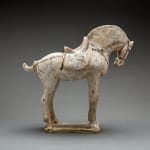Tang Sculpture of a Horse, 618 CE - 906 CE
Painted Terracotta
height 31.1 cm
height 12 1/4 in
height 12 1/4 in
H.860
Further images
During the Tang dynasty, China enjoyed a period of consolidation, achievement, and confidence. Tang art tends to reflect this assurance in its realism, energy, and dignity. Pottery of this era...
During the Tang dynasty, China enjoyed a period of consolidation, achievement, and confidence. Tang art tends to reflect this assurance in its realism, energy, and dignity. Pottery of this era is often compared to that of Classical Greece for the sophisticated achievements in sculpting and modeling. This statue resembles a portrait of an individual horse with its lifelike modeling and expressive facial features. Individual hairs of the mane and tail have been carefully painted onto the surface, in addition to the horse’s eye and reigns and harness, heightening the naturalism of the work. Furthermore, this work is notable for the position of the horse’s head, gently turned to the side, with an arched neck. Strong, noble, and splendid, this terracotta horse conveys the love and admiration that Tang society felt toward its steeds. As horses were often symbols of the afterlife, this funerary statue seems to be ready to bear his owner into the afterlife on his saddle, which still bears some remnants of the original orange polychrome that once brightly colored it. Horses held particular significance with Tang rulers and aristocrats, who relied on them for military preparedness and diplomatic policy. In addition, they were also revered for their religious significance: ancient tradition linked them to the dragon, designating them as supernatural creatures. Clearly, this horse was a beloved creature buried alongside the deceased to accompany him throughout eternity. This horse is ready to gallop across the eternal fields of the afterlife, carrying the spirit of the deceased upon its back.





